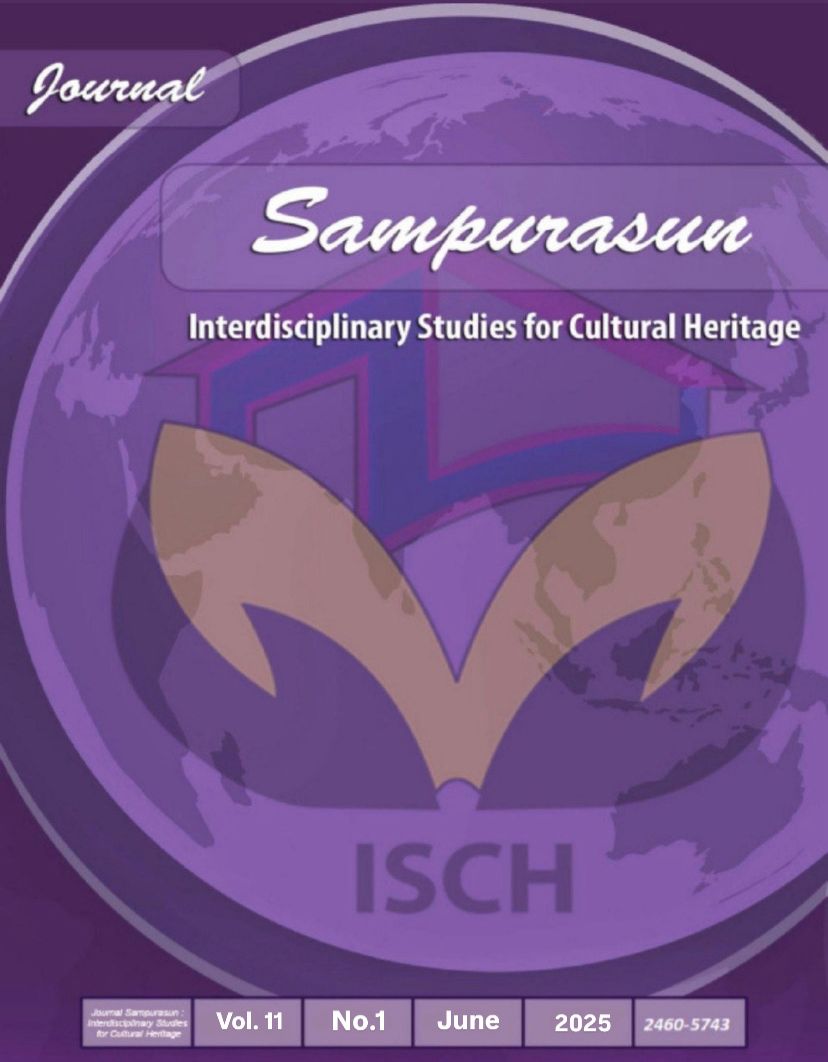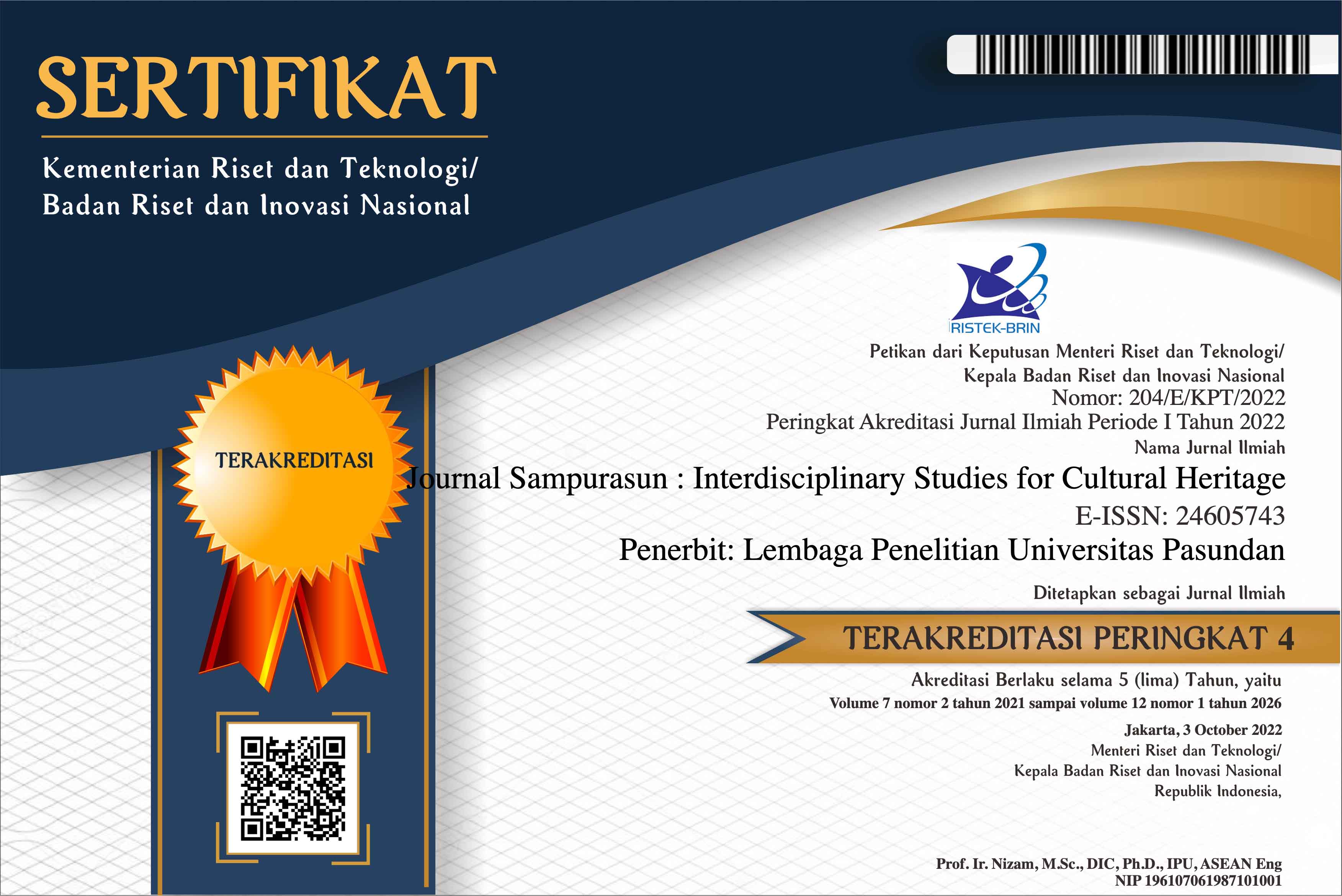SIGNAGE AS A MEDIUM TO STRENGTHEN CULTURAL IDENTITY: A CASE STUDY AT KAMPUNG BUDAYA SINDANG BARANG BOGOR
DOI:
https://doi.org/10.23969/sampurasun.v11i1.23438Keywords:
cultural identity, local wisdom, signageAbstract
Signage plays an important role in cultural heritage destinations, functioning not
only as wayfinding tools but also as communicative devices that reflects the cultural
identity of a place. In many regions, signage has evolved into a medium for cultural
storytelling through the use of local language, symbols, and traditional elements. However,
in several heritage sites in Indonesia, the cultural integration of signage remains
underdeveloped. This study investigates how signage contributes to the communication of
cultural identity in Kampung Budaya Sindang Barang, one of the oldest traditional villages
in Bogor. Despite its active role in preserving Sundanese tradition through rituals,
architecture, and educational programs, the village’s existing signage remains limited in
both quantity and cultural representation. This research employs qualitative case study
approach, using observation, interviews, and documentation to explore signage functions
within the village. Analysis was conducted using a SWOT matrix to identify internal and
external factors, while the pyramid signage model was applied to examine signage through
its information content, graphic, and hardware system. The findings reveal that the current
signage primarily fulfills functional purposes such as navigation and regulation, without
incorporating Sundanese language, symbols or motifs. This lack of cultural representation
reduces signage effectiveness in communicating identity and engaging visitors. The result
demonstrates a significant gap between the cultural richness of the site and its ability to
express identity through design. This study contributes to a deeper understanding of how
signage can serve as a medium for cultural expression and calls attention to the need for
contextually relevant signage in heritage tourism destination.
Keywords: Cultural Identity, Cultural Village, Signage, Sunda
Downloads
References
Ariwibowo, S., & Priaditya, D. N. P. (2019). A SEMIOTIC STUDY OF ICON AND SYMBOL OF SUBARU CAR IN AUTOMOTIVE ADVERTISEMENT. DINAMIKA, Jurnal Sastra Dan Budaya, 4. https://doi.org/https://doi.org/10.25139/dinamika.v4i2.1604
Aulia, M. F. (2024). Skema Perancangan Wayfinding – Signage bagi Desain Komunikasi Visual. Jurnal Desain, 11(2), 367. https://doi.org/10.30998/jd.v11i2.17695
Rizali, A. E. N., Ariani, A., Jasfi, E. F., Damayanti, R. A., & Ali, R. J. (2024). KAJIAN ESTETIKA PENERANGAN JALAN UMUM DI KAWASAN JALAN SENOPATI, JALAN SURYO, JALAN WOLTER MONGINSIDI, DAN JALAN GUNAWARMAN, JAKARTA SELATAN. Jurnal Dimensi Seni Rupa Dan Desain, 21(1), 15–34. https://doi.org/10.25105/dim.v21.i1.21325
Badan Pusat Statistik. (2024). Statistik Wisatawan Nusantara 2023.
Basil, M. (2011). Use of photography and video in observational research. In Qualitative Market Research: An International Journal (Vol. 14, Issue 3, pp. 246–257). https://doi.org/10.1108/13522751111137488
Business Signs. (2024, October 10). Top 9 Durable Material for Outdoor Signs. ImpactSigns.Com. https://www.impactsigns.com/outdoor-sign-material/
Calori, C., & Vanden-Eynden, D. (2015). Signage and Wayfinding Design (Second). John Wiley & Sons.
Cruz, L. C. I., & Sarmiento, L. M. Z. (2022). Qualitative Research as a Tool to Carry out Architectural and Industrial Design Projects: A Vision from the Academic Perspective. European Journal of Formal Sciences and Engineering, 5(2), 13–23. https://doi.org/10.26417/ejef.v3i3.p6-12
Daniswari, D. (2024, August 3). Kampung Budaya Sindang Barang di Bogor: Sejarah, Daya Tarik, dan Biaya. https://bandung.kompas.com/read/2024/08/03/225107078/kampung-budaya-sindang-barang-di-bogor-sejarah-daya-tarik-dan-biaya?page=all
Fauzan, M. R. (2024, August 30). Sejarah Kampung Budaya Sindang Barang Bogor, Destinasi Wisata yang Menonjolkan Kehidupan Tradisional Suku Sunda. https://radarbogor.jawapos.com/wisata/2475035725/sejarah-kampung-budaya-sindang-barang-bogor-destinasi-wisata-yang-menonjolkan-kehidupan-tradisional-suku-sunda
Fu, M., & Jang, C. (2024). Exploring Color Perception in Urban Signage: A Case Study of Busan Cinema Center. Asia-Pacific Journal of Convergent Research Interchange, 10(4), 523–538. https://doi.org/10.47116/apjcri.2024.04.40
Haryono, T. J. S. (2016). Konstruksi Identitas Budaya Bawean. In BioKultur (Issue 2).
Indonesia Kaya. (n.d.). Menyambangi Bekas Kasepuhan Sunda di Kampung Budaya Sindang Barang. Retrieved December 1, 2024, from https://indonesiakaya.com/pustaka-indonesia/menyambangi-bekas-kasepuhan-sunda-di-kampung-budaya-sindang-barang/
Ivanenko, V., Klimova, I., & Morozov, V. (2024). SWOT ANALYSIS: NAVIGATING SUSTAINABILITY AMID UNCERTAINTY. Economics. Management. Innovations, 1(34), 153–168. https://doi.org/10.35433/issn2410-3748-2024-1(34)-10
Jin, L. (2022). Research on the Integration of Traditional Arts and Crafts into the Design of Modern Cultural and Creative Products. 362. https://doi.org/10.2991/assehr.k.220109.075
Knott, E., Rao, A. H., Summers, K., & Teeger, C. (2022). Interviews in the social sciences. Nature Reviews Methods Primers, 2(1). https://doi.org/10.1038/s43586-022-00150-6
Koentjaraningrat. (1985). Pengantar Ilmu Antropologi (Kelima). Aksara Baru.
Lin, Y., Zeng, W., Ye, Y., & Qu, H. (2022). Saliency-aware color harmony models for outdoor signboard. Computers & Graphics, 105, 25–35. https://doi.org/10.1016/j.cag.2022.04.012
Marpaung, C. S. (2024). STUDI TATA LETAK KETERANGAN (LABEL) DISPLAY PAMERAN DI MUSEUM TEKSTIL JAKARTA. Jurnal Dimensi Seni Rupa Dan Desain, 21(1), 47–58. https://doi.org/10.25105/dim.v21.i1.21553
Nurkaidah, S. (2022, April 12). Mengenal Kampung Budaya Sindangbarang Bogor. https://kumparan.com/siti-nurkaidah-1/mengenal-kampung-budaya-sindangbarang-bogor-1xtRM8a1fbK/4
Ompusunggu, W. J., Dwisusanto, Y. B., Jalan Permukiman Objek Studi, S., & Braga, P. (2022). SETTLEMENT ROAD SIGNAGE OBJECT OF STUDY: SETTLEMENT OF BRAGA. In www.journal.unpar.ac.id (Vol. 06). www.journal.unpar.ac.id
Purba, M. O., Yulita, S., & Marpaung, W. L. (2023). Kampung Budaya Sindang Barang sebagai Kearifan Lokal Budaya di Indonesia. INNOVATIVE: Journal of Social Science Research, 3, 8166–8171. https://doi.org/https://doi.org/10.31004/innovative.v3i2
Putra, F. S. D., & Ayuswantana, A. (2023). Flat Design Sebagai Gaya Visual Perancangan Asset Bangunan Pada Web “Peta Interaktif.” Journal of Creative Student Research, 1(6), 178–187. https://doi.org/10.55606/jcsrpolitama.v1i6.2947
Senekane, M. F. (2024). The Selection of Data Collection Methods. In https://services.igi-global.com/resolvedoi/resolve.aspx?doi=10.4018/979-8-3693-1135-6.ch004 (pp. 75–92). IGI Global Scientific Publishing. https://doi.org/10.4018/979-8-3693-1135-6.ch004
Sieras, S. G. (2024). Impact and Identities as Revealed in Tourists’ Perceptions of the Linguistic Landscape in Tourist Destinations. International Journal of Language and Literary Studies, 6(1), 375–392. https://doi.org/10.36892/ijlls.v6i1.1644
Tjhin, S. (2019). Analysis Signage Systems Based on Local Wisdom: Study Case Setu Babakan. Open Journal of Science and Technology, 2(1), 1–7. https://doi.org/10.31580/ojst.v2i1.902
Wansink, B. (2019). Useful observational research. In Context: The Effects of Environment on Product Design and Evaluation (pp. 87–110). Elsevier. https://doi.org/10.1016/B978-0-12-814495-4.00005-2
Widyastuty, A. A. A. (2021). Pariwisata Alam dan Budaya. Revka Prima Media.
Yi, J. H., & Jeon, J. (2022). A study on color conspicuity and color harmony of wayfinding signs according to outdoor environment types. Color Research & Application, 47(6), 1259–1294. https://doi.org/10.1002/col.22808
Yijing, C., & Sharudin, S. A. (2023). The Integration of Traditional Symbols and Modern Product Design: Cultural Inheritance and Innovation. Global Journal of Emerging Science, Engineering & Technology, 1(1), 19–25. https://doi.org/10.56225/gjeset.v1i1.17
Additional Files
Published
Issue
Section
License
Copyright (c) 2025 Journal Sampurasun : Interdisciplinary Studies for Cultural Heritage

This work is licensed under a Creative Commons Attribution 4.0 International License.
Copyright Notice
Authors should not withdraw their submitted papers because the withdrawal wastes voluntary works devoted by an associate editor and reviewers. But, we accept the withdrawal of a submitted paper if authors have unavoidable reasons. In the event that a manuscript is to be withdrawn from submission to Sampurasun Journal, a letter must be sent to the editorial office requesting withdrawal by e-mail (sampurasunjournal@unpas.ac.id) with its scanned PDF file, before the notification of acceptance for publication.
The withdraw request letter must include the following information. Paper ID, Paper title, Authors names, Reason why the paper must be withdrawn, and Date and signatures of all the authors (or signature of the contact author).
If only the contact author signs the letter, he/she must obtain the agreement of the withdrawal from all the other authors and the letter must include the description that all the other authors agreed the withdrawal. The journal will not withdraw a manuscript from peer review until such a letter has been received. Authors must not assume their manuscript has been withdrawn until they have received appropriate notification from the editorial office. Withdrawal of a manuscript subsequent to acceptance for publication will only be granted in the most exceptional of circumstances.
After the paper is accepted for publication, the withdrawal is not permitted in principle. The authors must always pay the charge even if the withdrawal is permitted. Any request of withdrawal that does not follow the above procedure is treated as invalid. If illegal submission, e.g., plagiarized or duplicate submission, is found for a paper, the withdrawal of the paper will never be permitted and the authors will be punished based on the rule. It is not acceptable practice to withdraw a manuscript in the event of acceptance at another journal. This constitutes dual submission. The editorial office of the other journal will be notified of your actions. In such circumstances Sampurasun ISCH may chose to impose appropriate punitive action subject.
Withdrawal Penalty
Author is not allowed to withdraw submitted manuscripts, because the withdrawal is waste of valuable resources that editors and referees spent a great deal of time processing submitted manuscript, money and works invested by the publisher. If author still requests withdrawal of his/her manuscript when the manuscript is still in the peer-reviewing process, author will be punished with paying $200 per manuscript, as withdrawal penalty to the publisher. However, it is unethical to withdraw a submitted manuscript from one journal if accepted by another journal. The withdrawal of manuscript after the manuscript is accepted for publication, author will be punished by paying US$500 per manuscript. Withdrawal of manuscript is only allowed after withdrawal penalty has been fully paid to the Publisher. If author don't agree to pay the penalty, the author and his/her affiliation will be blacklisted for publication in this journal. Even, his/her previously published articles will be removed from our online system.


















